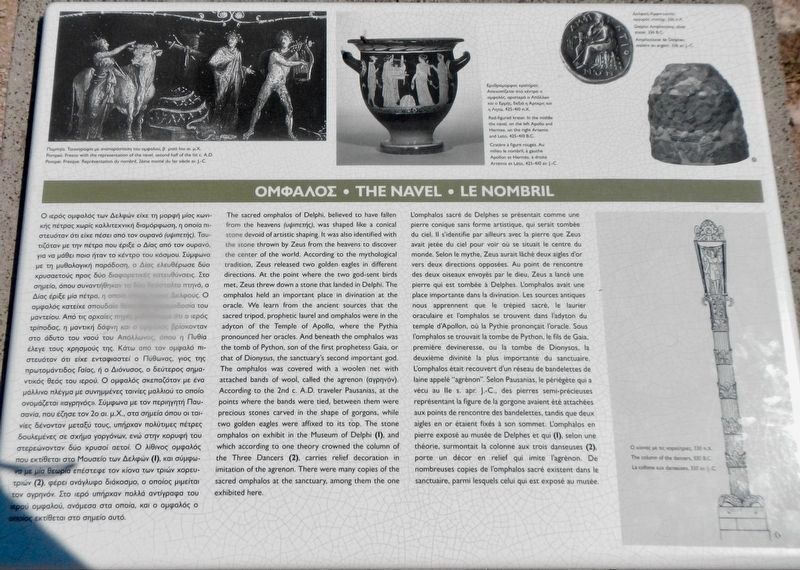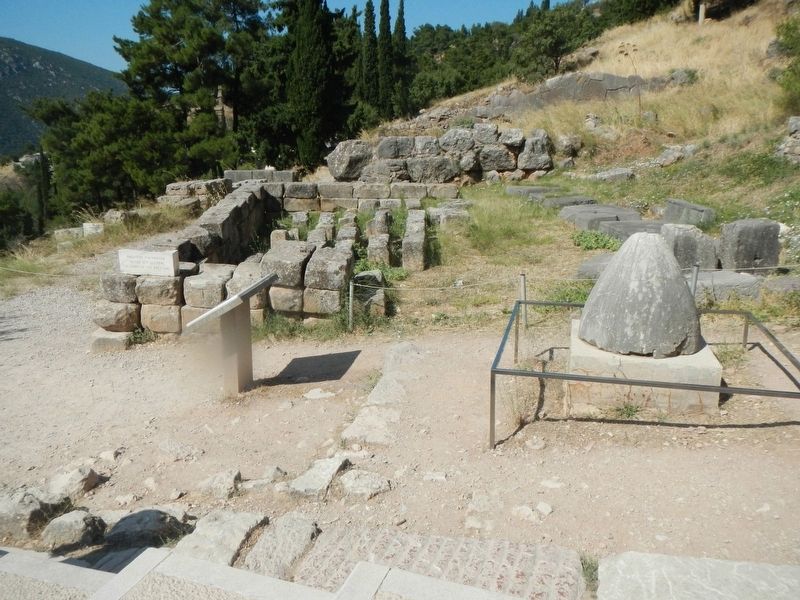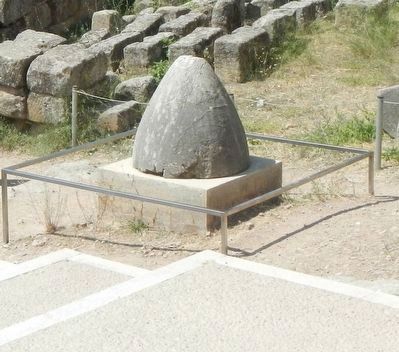Delfi in Phocis, Thessaly and Central Greece, Greece — Ελλάδα (Southeastern Europe, Balkan Peninsula)
The Navel
OMΦAΛOΣ
— Le Nombril —

Photographed By Barry Swackhamer, July 21, 2018
1. The Navel Marker
Captions: (top left) Pompeii Fresco with the representation of the navel, second half of the 1st c. A.D.; (top center) Red-figured krater. In the middle of the navel, on the left Apollo and Hermes, on the right Artemis and Leto. 425-410 B.C.; (top right) Delphic Ammphiotiony silver starter 336 B.C.; (upper right) object no. 1; (bottom right) (object no. 2) The column of the dancers, 330 B.C.
English:
The sacred omphalos of Delphi, believed to have fallen from the heavens (υψιπετήζ), was shaped like a conical stone devoid of artistic shaping. It was also identified with the stone thrown by Zeus from the heavens to discover the center the world. According to the mythological tradition, Zeus released two golden eagles in different directions. At the point where the two god-sent birds met, Zeus threw down a stone that landed in Delphi. The omphalos held an important place in divination at the oracle . We learn from the ancient sources that the sacred tripod, prophetic laurel and omphalos were in the adyton of the Temple of Apollo, where the Pythia pronounced her oracles. And beneath the omphalos was the tomb of Python, son of the first prophetess Gaia, or that of Dionysus, the sanctuary's second important god. The omphalos was covered with a wooden net with attached bands of wool, called the agrenon (αγρηνόν). According to the 2nd c. A.D. traveler Pausanias, at the points where the bands were tied, between them were precious stones carved in the shape of gorgons, while two golden eagles were affixed to its top. The stone omphalos on exhibit in the Museum of Delphi (1), and which according to one theory crowned the column of the Three Dancers (2), carries relief decoration in imitation of the agrenon. There were many copies of the sacred omphalos at the sanctuary, among them the one exhibited here.
Erected by Greek Ministry of Culture and Sports.
Topics. This historical marker is listed in these topic lists: Anthropology & Archaeology • Man-Made Features.
Location. 38° 28.9′ N, 22° 30.079′ E. Marker is in Delfi, Thessaly and Central Greece, in Phocis. Marker is on Ethniki Odos Livadias Amfissas (Route EO 48), on the left when traveling east. Touch for map. Marker is in this post office area: Delfi, Thessaly and Central Greece 330 54, Greece. Touch for directions.
Other nearby markers. At least 8 other markers are within walking distance of this marker. The Treasury of the Sikyonians and Siphnians (a few steps from this marker); The Halos (within shouting distance of this marker); The Temple of Apollo (about 90 meters away, measured in a direct line); Monuments of the Sacred Way (about 90 meters away); The (Delphi) Theatre (about 120 meters away); The Altar of Chiots Area (about 120 meters away); The Theater District (about 120 meters away); The Sanctuary of Apollo (about 120 meters away). Touch for a list and map of all markers in Delfi.
More about this marker. This marker is located inside the Sanctuary of Apollo.
Credits. This page was last revised on March 21, 2022. It was originally submitted on November 14, 2018, by Barry Swackhamer of Brentwood, California. This page has been viewed 335 times since then and 50 times this year. Photos: 1, 2, 3. submitted on November 14, 2018, by Barry Swackhamer of Brentwood, California.

